Assessment and Prediction of Extreme Temperature Indices in the North China Plain by CMIP6 Climate Model
Abstract
:1. Introduction
2. Materials and Methods
2.1. Overview of the Study Area
2.2. Data Sources
- SSP126 is a scenario with a stable radiative forcing of 2.6 W/m2 in 2100 [21];
- SSP245 is a medium forcing scenario, and the radiative forcing is stabilized at 4.5 W/m2 in 2100;
- SSP370 is a net radiative forcing scenario with a stable radiative forcing of 7.0 W/m2 in 2100, which represents a mixture of high social vulnerability and relatively high perceived radiative forcing [22];
- SSP585 achieves a strong forcing scenario in 2100, with an anthropogenic radiative forcing of 8.5 W/m2.
2.3. Extreme Temperature Indices
2.4. The Support Vector Machine
3. Results
3.1. Simulation and Assessment of Extreme Temperature Indices in the North China Plain during the Historical Period
3.2. Temporal Variability Characteristics of Extreme Climate Index Changes under Future Climate Scenarios
3.3. Spatial Variation Characteristics of Extreme Temperature Indices in the North China Plain
4. Discussion
5. Conclusions
- (1)
- The simulated values of extreme temperature indices from the multi-climate model SVM method better agree with the observed values than individual GCM models. The arithmetic means method is suitable for simulating and predicting extreme temperature indices in the North China Plain.
- (2)
- The extreme high temperature indices (TXx, TNx, TXn, TNn, TN90p, TX90p, and SU) indicate a considerable growing tendency for the four future climate scenarios (2061–2100), whereas the extreme low temperature indices drop dramatically. TXx, TNx, TN90p, and TX90p altered the most in the SSP585 climate scenario, whereas TXx, TNx, TN90p, and TX90p changed the least with the SSP126 climate scenario. Under different climate scenarios, TXn, TNn, and Su did not alter appreciably.
- (3)
- In the North China Plain, there are significant spatial differences in extreme temperature indices in both historical and future periods, except DTR. The variance in the extreme temperature index grows with the growth of the scenario’s radiative forcing, and spatial differences become more pronounced, reaching a maximum under the SSP585 climate scenario.
Author Contributions
Funding
Acknowledgments
Conflicts of Interest
References
- Stocker, T.F.; Qin, D.; Plattner, G.; Tignor, M.M.; Allen, S.K.; Boschung, J.; Nauels, A.; Xia, Y.; Bex, V.; Midgley, P.M.; et al. Climate Change 2013. The Physical Science Basis. In Working Group I Contribution to the Fifth Assessment Report of the Intergovernmental Panel on Climate Change; Cambridge University Press: Cambridge, UK, 2014. [Google Scholar]
- Bai, H.; Xiao, D.; Liu, J.; Wang, H.; Zhang, H.; Li, Z. Spatio-temporal pattern of extreme climate events and agro-meteorological disasters in North China from 1965 to 2014. Geogr. Geoinform. Sci. 2018, 34, 99–105. [Google Scholar]
- Zhao, Y.; Xiao, D.; Bai, H. Prediction and application of CMIP5 climate model for future climate change in China. Meteorol. Sci. Technol. 2019, 47, 608–621. [Google Scholar]
- Zhou, T.; Zou, L.; Chen, X. Review of the Sixth International Comparative Program of Coupled Models (CMIP6). Prog. Clim. Chang. Res. 2019, 87, 5–16. [Google Scholar]
- Fu, Y.; Lin, Z.; Guo, D. Improvement of the simulation of the summer East Asian westerly jet from CMIP5 to CMIP6. Atmos. Ocean. Sci. Lett. 2020, 13, 550–558. [Google Scholar] [CrossRef] [Green Version]
- Kim, Y.H.; Min, S.K.; Zhang, X.; Sillmann, J.; Sandstad, M. Evaluation of the CMIP6 multi-model ensemble for climate extreme indices. Weather. Clim. Extrem. 2020, 29, 100269. [Google Scholar] [CrossRef]
- Chen, H.P.; Sun, J.Q. Robustness of Precipitation Projections in China: Comparison between CMIP5 and CMIP3 Models. Atmos. Ocean. Sci. Lett. Engl. Ed. 2014, 7, 67–73. [Google Scholar]
- Yyzab, C.; Syab, C. Evaluation of CMIP6 for historical temperature and precipitation over the Tibetan Plateau and its comparison with CMIP5. Adv. Clim. Chang. Res. 2020, 11, 239–251. [Google Scholar]
- You, Q.; Cai, Z.; Wu, F.; Jiang, Z.; Pepin, N.; Shen, S.S. Temperature dataset of CMIP6 models over China: Evaluation, trend and uncertainty. Clim. Dyn. 2021, 57, 17–35. [Google Scholar] [CrossRef]
- Tian, D.; Guo, Y.; Dong, W. Future Changes and Uncertainties in Temperature and Precipitation over China Based on CMIP5 Models. Adv. Atmos. Sci. Engl. 2015, 32, 10. [Google Scholar] [CrossRef]
- Xiao, D.; Zhao, Y.; Bai, H.; Tang, J.; Feng, P.; Liu, D. Modeling and estimation of climate in the North China Plain by cmip5 global climate model. Geogr. Geo-Inf. Sci. 2020, 36, 8. [Google Scholar]
- Yu, S. Analysis and prediction model of meteorological environment and winter heating energy consumption of hospitals based on machine learning. China Equip. Eng. 2021, 27–28. [Google Scholar]
- Dong, J.; Wu, L.; Liu, X.; Fan, C.; Leng, M.; Yang, Q. Simulation of Daily Diffuse Solar Radiation Based on Three Machine Learning Models. Comput. Model. Eng. Sci. 2020, 123, 49–73. [Google Scholar] [CrossRef]
- Chen, J.L.; Li, G.S.; Xiao, B.B.; Wen, Z.F.; Lv, M.Q.; Chen, C.D.; Jiang, Y.; Wang, X.X.; Wu, S.J. Assessing the transferability of support vector machine model for estimation of global solar radiation from air temperature. Energy Convers. Manag. 2015, 89, 318–329. [Google Scholar] [CrossRef]
- Chen, J.L.; Li, G.S. Evaluation of Support Vector Machine for Estimation of Solar Radiation from Measured Meteorological Variables; Springer: Vienna, Austria, 2014. [Google Scholar]
- Chapelle, O.; Haffner, P.; Vapnik, V.N. Support Vector Machines for Histogram-Based Image Classification. IEEE Trans. Neural Netw. 1999, 10, 1055–1064. [Google Scholar] [CrossRef] [PubMed]
- Elguindi, N.; Grundstein, A.; Bernardes, S.; Turuncoglu, U.; Feddema, J. Assessment of CMIP5 global model simulations and climate change projections for the 21st century using a modified Thornthwaite climate classification. Clim. Chang. 2014, 122, 523–538. [Google Scholar] [CrossRef]
- Zhao, Y.; Zhu, J.; Xu, Y. Establishment and quality assessment of precipitation grid data set in China in recent 50a. Meteorol. Sci. 2014, 34, 414–420. [Google Scholar]
- Taylor, K.E.; Stouffer, R.J.; Meehl, G.A. An Overview of CMIP5 and the Experiment Design. Bull. Am. Meteorol. Soc. 2012, 93, 485–498. [Google Scholar] [CrossRef] [Green Version]
- Moss, R.H.; Edmonds, J.A.; Hibbard, K.A.; Manning, M.R.; Rose, S.K.; Van Vuuren, D.P.; Carter, T.R.; Emori, S.; Kainuma, M.; Kram, T. The next generation of scenarios for climate change research and assessment. Nature 2010, 463, 747–756. [Google Scholar] [CrossRef]
- Zhang, L.; Chen, X.; Xin, X. Overview and review of THE CMIP6 Scenario Model Comparison Plan (Scenari-oMIP). Prog. Clim. Chang. Res. 2019, 15, 519–525. [Google Scholar]
- Tebaldi, C.; Debeire, K.; Eyring, V.; Fischer, E.; Fyfe, J.; Friedlingstein, P.; Knutti, R.; Lowe, J.; O’Neill, B.; Sanderson, B.; et al. Climate model projections from the Scenario Model Intercomparison Project (ScenarioMIP) of CMIP6. Earth Syst. Dyn. 2021, 12, 253–293. [Google Scholar] [CrossRef]
- Liu, D.L.; Zuo, H. Statistical downscaling of daily climate variables for climate change impact assessment over New South Wales, Australia. Clim. Chang. 2012, 115, 629–666. [Google Scholar] [CrossRef]
- Zhi, L.; Zheng, F.L.; Liu, W.Z.; Jiang, D.J. Spatially downscaling GCMs outputs to project changes in extreme precipitation and temperature events on the Loess Plateau of China during the 21st Century. Glob. Planet. Chang. 2012, 82–83, 65–73. [Google Scholar]
- Cortes, C. Support-Vector Networks. Mach. Learn. 1995, 20, 273–297. [Google Scholar] [CrossRef]
- Chen, L. Improving Least Squares Support Vector Machine and Its Application; East China Jiaotong University: Nanchang, China, 2014. [Google Scholar]
- Su, Y.X.; Xu, H.; Yan, L.J. Support Vector Machine-Based Open Crop Model (SBOCM): Case of Rice Production in China. Saudi J. Biol. Sci. 2017, 24, 537–547. [Google Scholar] [CrossRef]
- Wang, H.; Xiao, D.; Zhao, Y.; Bai, H.; Zhang, K.; Tang, J.; Liu, J.; Guo, F.; Liu, D. Evaluation and prediction of extreme temperature index in North China Plain based on CMIP6 climate model. Geogr. Geoinform. Sci. 2021, 37, 86–94, 142. [Google Scholar]
- Zhou, T.; Chen, X. Uncertainty problems of climate sensitivity, climate feedback process and 2 °C warming threshold value. Acta Meteorol. Sin. 2015, 73, 624–634. [Google Scholar]
- Cheng, A.; Feng, Q.; Zhang, J.; Li, Z.; Wang, G. A review on the response process of climate change under future climate scenarios. Geogr. Sci. 2015, 35, 84–90. [Google Scholar]
- Fowler, H.J.; Blenkinsop, S.; Tebaldi, C. Linking Climate Change Modelling to Impacts Studies: Recent Advances in Downscaling Techniques for Hydrological Modelling; Wiley-Blackwell: Hoboken, NJ, USA, 2007. [Google Scholar]
- Hao, L.; Xiang, L.; Zhang, J. Test analysis of China’s climate change projection data in Hebei Province. J. Atmos. Sci. 2015, 38, 362–370. [Google Scholar]
- Chen, H.; Yang, T.; Hu, G.; Wang, S. Analysis of evaporation change of reservoir in Yeerqiang Basin under climate change. People’s Yangtze River 2016, 47, 31–34. [Google Scholar]
- Chen, L. Prediction of CMIP5 model on the change of extreme precipitation events in China at the end of the 21st century. Sci. Bull. 2013, 58, 743–752. [Google Scholar]
- Hu, Q.; Jiang, D.; Fan, G. Assessment of the ability of CMIP5 global climate model to simulate climate on the Tibetan Plateau. Atmos. Sci. 2014, 38, 924–938. [Google Scholar]
- Xu, Y.; Gao, X.; Giorgi, F. Upgrades to the reliability ensemble averaging method for producing probabilistic climate-change projections. Clim. Res. 2010, 41, 61–81. [Google Scholar] [CrossRef] [Green Version]

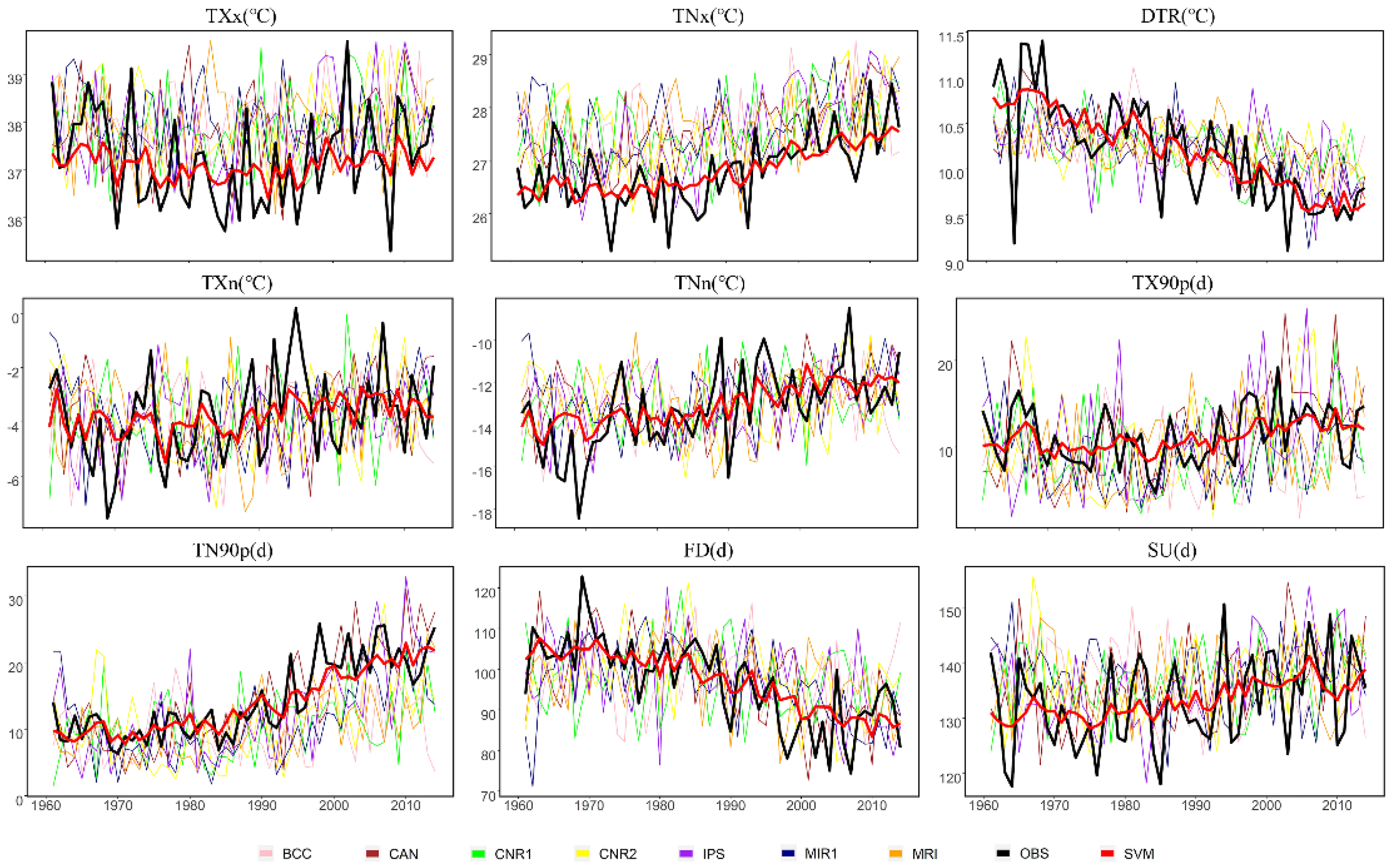
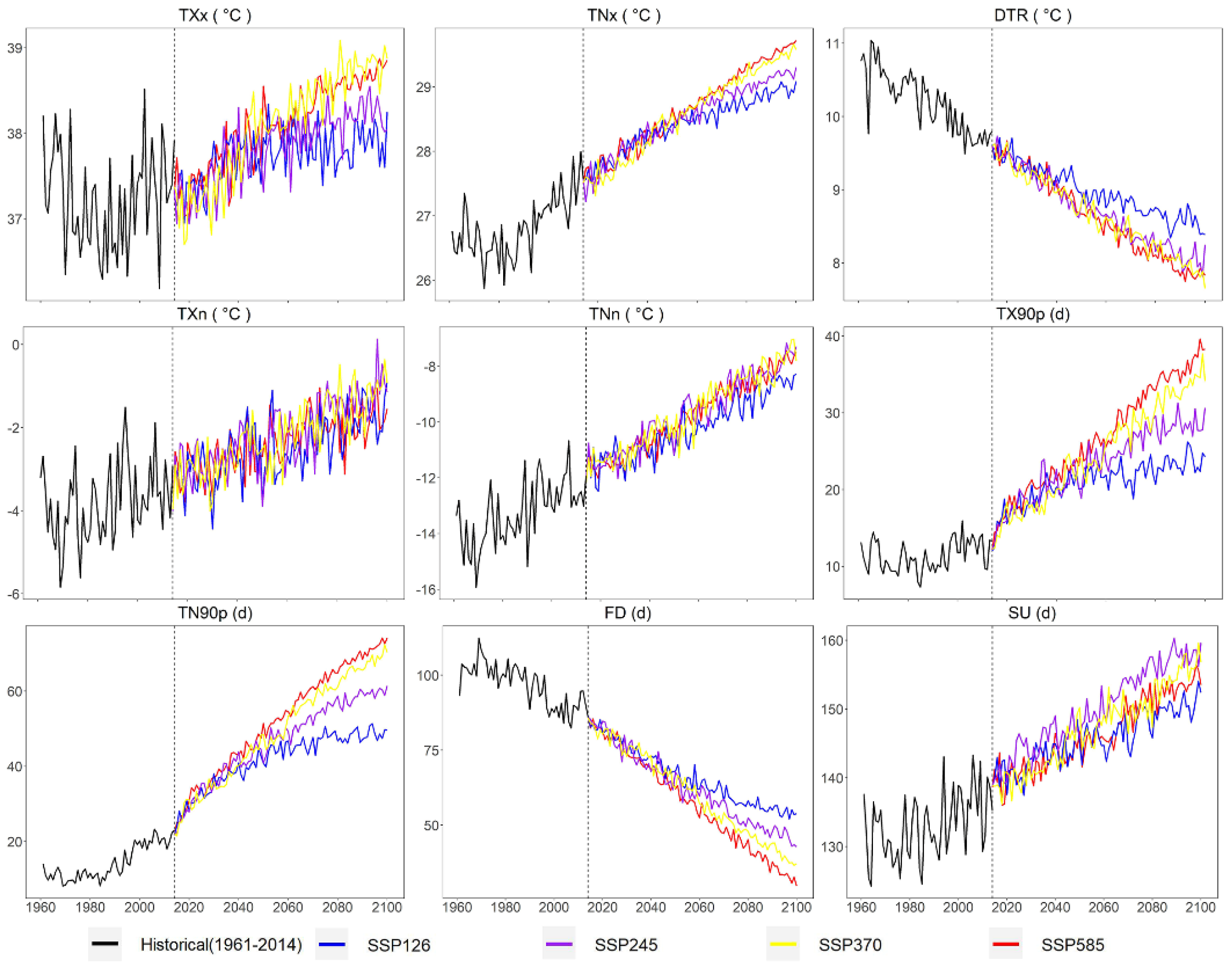


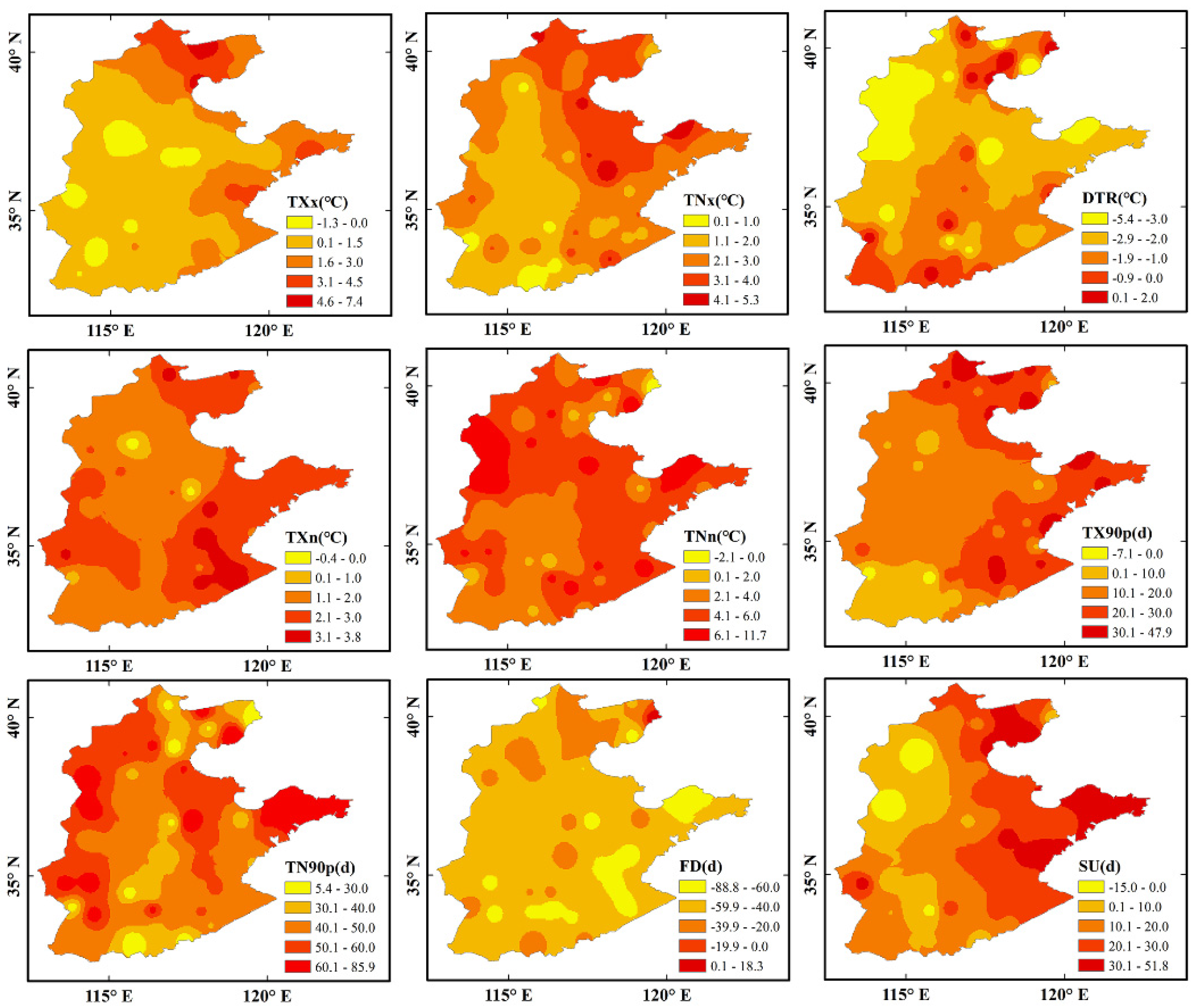
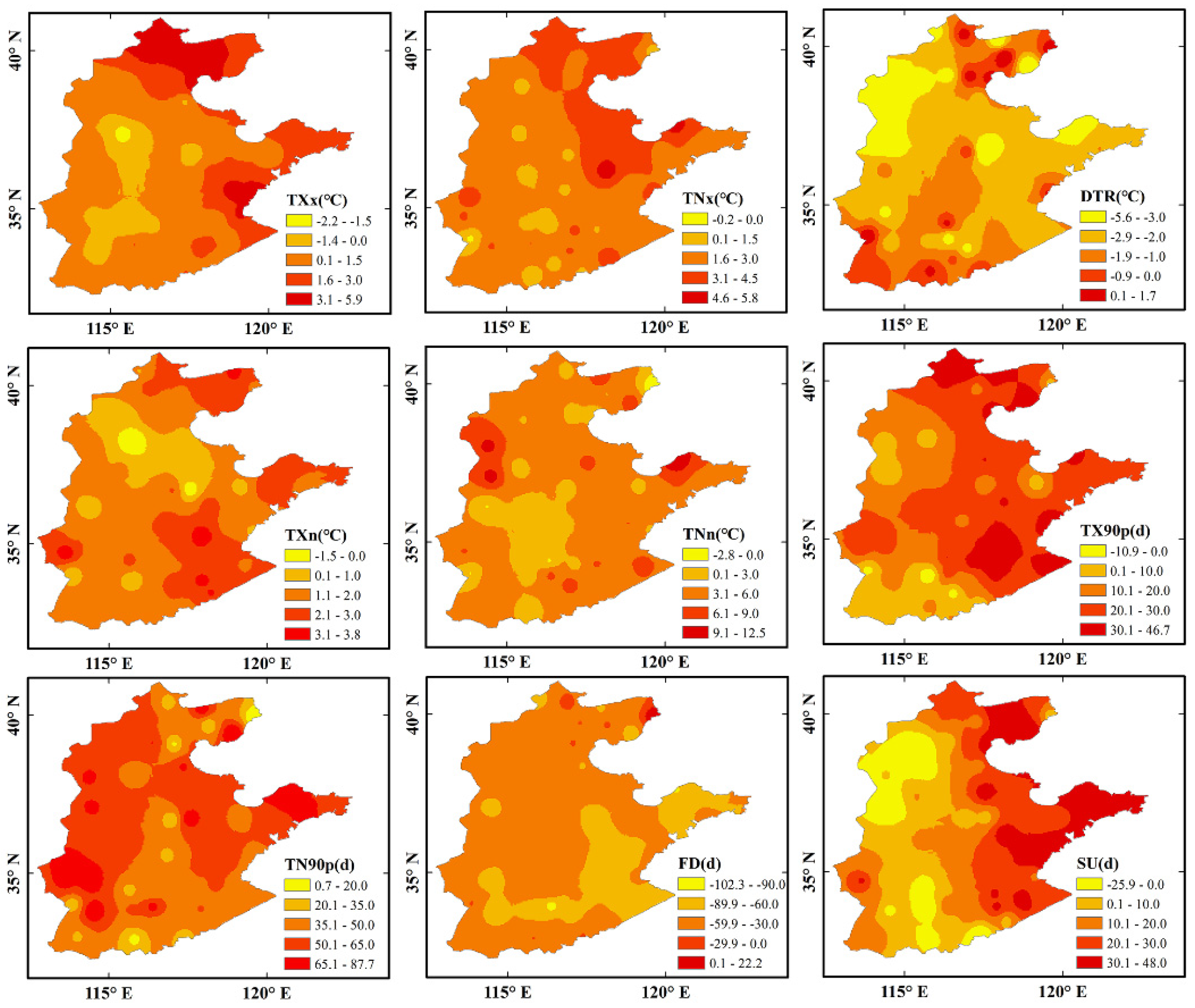
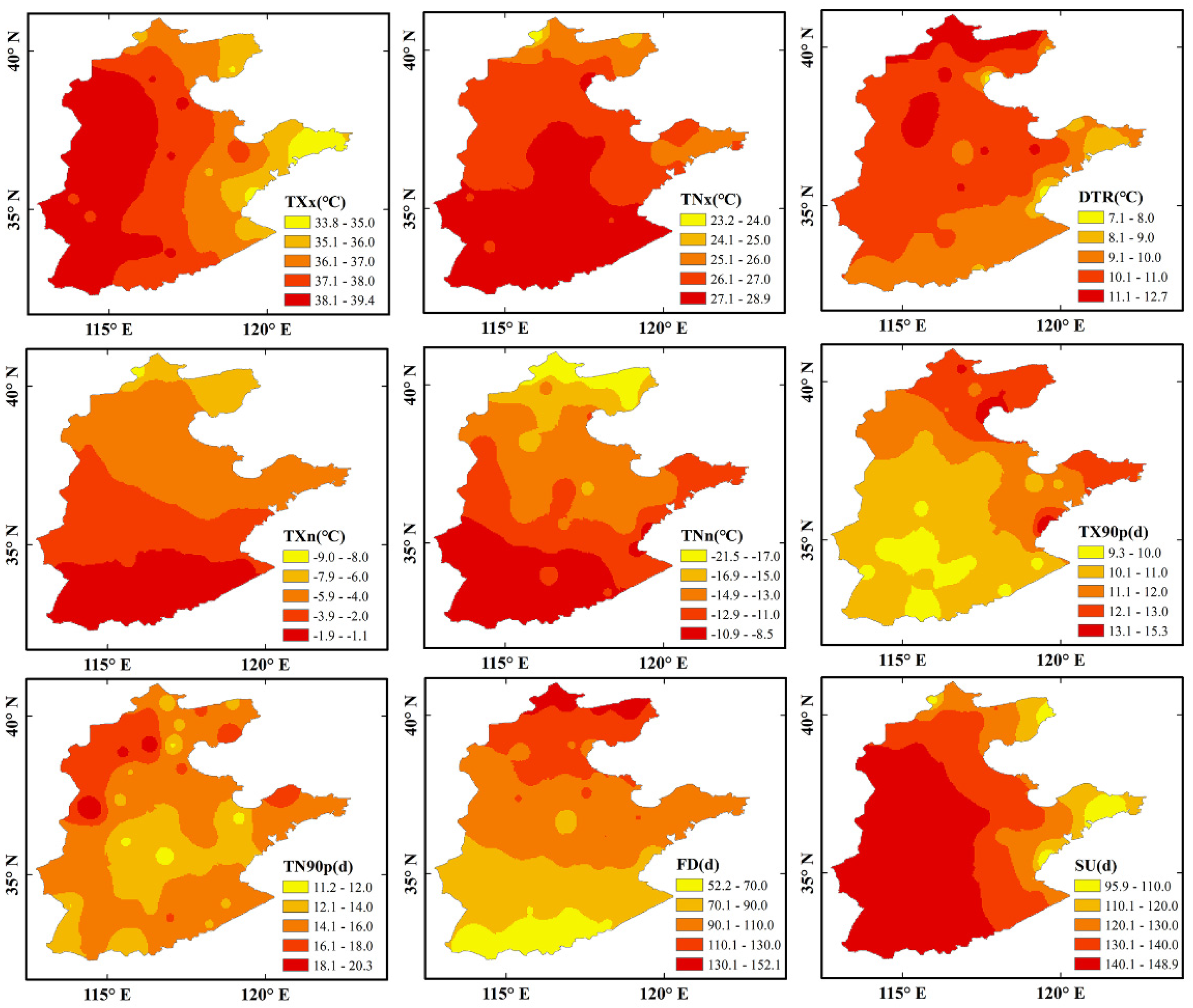
| ID | GCM Name | GCM Abbreviations | The Developer | COUNTRY/AREA |
|---|---|---|---|---|
| 1 | BCC-CSM2-MR | BCC | BCC | China |
| 2 | CanESM5 | CAN | CCCMA | Canada |
| 3 | CNRM-CM6-1 | CNR1 | CNRM | France |
| 4 | CNRM-ESM2-1 | CNR2 | CNRM | France |
| 5 | IPSL-CM6A-LR | IPS | IPSL | France |
| 6 | MIROC6 | MIR1 | MIROC | Japan |
| 7 | MRI-ESM2-0 | MRI | MRI | Japan |
| ID | Descriptive Name | Definition |
|---|---|---|
| TXx | Hottest day | Highest TX (°C) |
| TNx | Hottest night | Highest TN (°C) |
| DTR | Diurnal temperature range | Average difference between TX and TN (°C) |
| TXn | Coldest day | Lowest TX (°C) |
| TNn | Coldest night | Lowest TN (°C) |
| TX90p | Warm days | Number of days when TX > 90th percentile (d) |
| TN90p | Warm nights | Number of days when TN > 90th percentile (d) |
| SU | Summer days | Number of days with TX > 25 °C (d) |
| FD | Frost days | Number of days with TN < 0 °C (d) |
| GCMs | TXx | TNx | DTR | TXn | TNn | TX90p | TN90p | FD | SU |
|---|---|---|---|---|---|---|---|---|---|
| BCC | 2.00 (5.38%) | 1.67 (6.24%) | 0.68 (6.68%) | 2.31 (79.64%) | 2.94 (22.81%) | 6.60 (58.43) | 8.66 (60.55%) | 15.35 (17.28%) | 13.88 (11.11%) |
| CAN | 2.03 (5.47%) | 1.58 (5.89%) | 0.73 (7.23%) | 2.46 (86.65%) | 2.88 (22.46%) | 6.62 (58.83%) | 7.03 (50.02%) | 13.31 (14.89%) | 14.27 (11.30%) |
| CNR1 | 2.05 (5.53%) | 1.62 (6.05%) | 0.76 (7.45%) | 2.68 (96.35%) | 3.18 (25.02%) | 6.55 (58.14%) | 8.59 (60.00%) | 16.07 (18.20%) | 14.03 (11.11%) |
| CNR2 | 1.91 (5.16%) | 1.59 (5.94%) | 0.77 (7.58%) | 2.63 (90.56%) | 3.23 (25.16%) | 6.17 (55.00%) | 7.73 (54.33%) | 14.13 (15.88%) | 13.00 (10.34%) |
| IPS | 2.06 (5.55%) | 1.57 (5.87%) | 0.75 (7.43%) | 2.66 (92.95%) | 3.10 (24.16%) | 7.02 (62.47%) | 7.60 (53.72%) | 14.89 (16.66%) | 13.63 (10.86%) |
| MIR1 | 2.04 (5.48%) | 1.63 (6.08%) | 0.72 (7.12%) | 2.46 (87.00%) | 3.06 (23.91%) | 6.53 (57.94%) | 7.91 (55.41%) | 14.13 (15.85%) | 14.73 (11.74%) |
| MRI | 2.14 (5.75%) | 1.66 (6.19%) | 0.73 (7.19%) | 2.65 (91.11%) | 3.16 (24.61%) | 6.66 (59.33%) | 7.69 (53.61%) | 14.08 (15.97%) | 13.46 (10.62%) |
| MEAN | 1.75 (4.72%) | 1.41 (5.25%) | 0.66 (6.48%) | 2.12 (73.32%) | 2.68 (21.00%) | 4.31 (38.18%) | 5.88 (40.93%) | 11.55 (12.94%) | 11.44 (9.08%) |
| SVM | 1.38 (3.71%) | 0.90 (3.36%) | 0.54 (5.33%) | 1.76 (60.45%) | 2.30 (17.96%) | 3.66 (32.63%) | 4.27 (30.12%) | 9.48 (10.61%) | 9.17 (7.27%) |
| GCMs | TXx (°C/10a) | TNx (°C/10a) | DTR (°C/10a) | TXn (°C/10a) | TNn (°C/10a) | TX90p (d/10a) | TN90p (d/10a) | FD (d/10a) | SU (d/10a) |
|---|---|---|---|---|---|---|---|---|---|
| BCC | −0.03 | 0.07 | −0.12 | 0.02 | 0.04 | −0.26 | 0.80 | −0.52 | −0.62 |
| CAN | 0.10 | 0.30 | −0.12 | 0.29 | 0.43 | 1.67 | 3.82 | −3.64 | 1.93 |
| CNR1 | 0.04 | 0.16 | −0.09 | 0.09 | 0.17 | 0.18 | 1.05 | −0.79 | 0.91 |
| CNR2 | 0.10 | 0.18 | −0.04 | 0.03 | 0.08 | 1.11 | 1.65 | −1.83 | 1.40 |
| IPS | 0.16 | 0.30 | −0.09 | 0.12 | 0.28 | 1.24 | 2.77 | −2.55 | 2.13 |
| MIR1 | −0.11 | 0.10 | −0.19 | 0.16 | 0.28 | −0.13 | 1.57 | −2.45 | −1.03 |
| MRI | 0.04 | 0.13 | −0.09 | 0.02 | 0.14 | 0.53 | 1.47 | −1.55 | 0.31 |
| MEAN | 0.04 | 0.18 | −0.10 | 0.10 | 0.20 | 0.62 | 1.88 | −1.90 | 0.72 |
| OBS | 0.01 | 0.24 | −0.27 | 0.30 | 0.70 | 0.45 | 2.92 | −4.76 | 1.66 |
| SVM | 0.01 | 0.23 | −0.26 | 0.19 | 0.51 | 0.57 | 2.73 | −4.16 | 1.62 |
Publisher’s Note: MDPI stays neutral with regard to jurisdictional claims in published maps and institutional affiliations. |
© 2022 by the authors. Licensee MDPI, Basel, Switzerland. This article is an open access article distributed under the terms and conditions of the Creative Commons Attribution (CC BY) license (https://creativecommons.org/licenses/by/4.0/).
Share and Cite
Wang, H.; Wang, L.; Yan, G.; Bai, H.; Zhao, Y.; Ju, M.; Xu, X.; Yan, J.; Xiao, D.; Chen, L. Assessment and Prediction of Extreme Temperature Indices in the North China Plain by CMIP6 Climate Model. Appl. Sci. 2022, 12, 7201. https://doi.org/10.3390/app12147201
Wang H, Wang L, Yan G, Bai H, Zhao Y, Ju M, Xu X, Yan J, Xiao D, Chen L. Assessment and Prediction of Extreme Temperature Indices in the North China Plain by CMIP6 Climate Model. Applied Sciences. 2022; 12(14):7201. https://doi.org/10.3390/app12147201
Chicago/Turabian StyleWang, Hui, Lu Wang, Guoying Yan, Huizi Bai, Yanxi Zhao, Minmin Ju, Xiaoting Xu, Jing Yan, Dengpan Xiao, and Lirong Chen. 2022. "Assessment and Prediction of Extreme Temperature Indices in the North China Plain by CMIP6 Climate Model" Applied Sciences 12, no. 14: 7201. https://doi.org/10.3390/app12147201
APA StyleWang, H., Wang, L., Yan, G., Bai, H., Zhao, Y., Ju, M., Xu, X., Yan, J., Xiao, D., & Chen, L. (2022). Assessment and Prediction of Extreme Temperature Indices in the North China Plain by CMIP6 Climate Model. Applied Sciences, 12(14), 7201. https://doi.org/10.3390/app12147201







